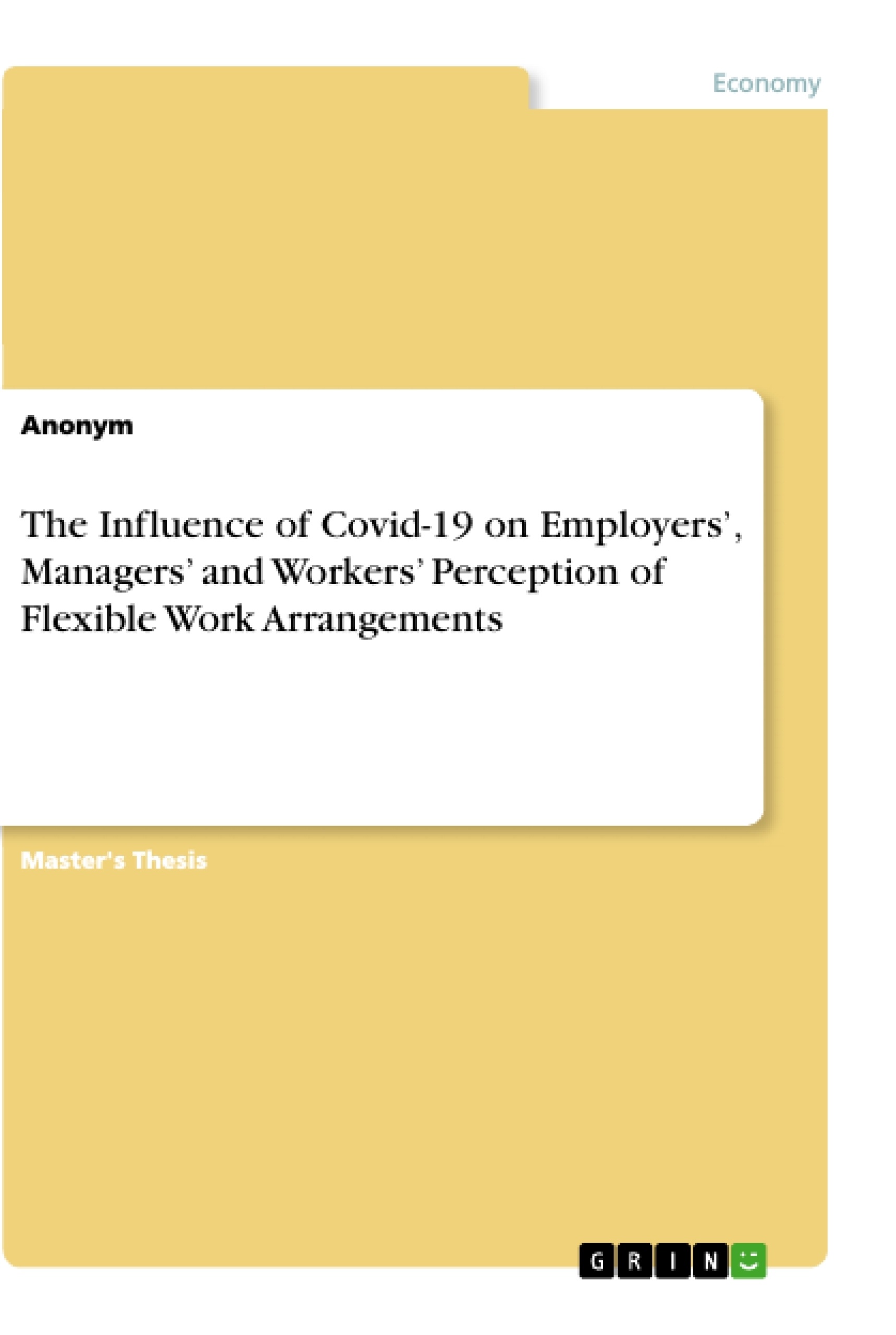During the Covid-19 pandemic, the characteristics of flexible work arrangements changed from mainly voluntary to compulsory. Previous studies have mainly focused on quantitative surveys. However, no research has been conducted to date into whether and to what extent the perception and the effects on subjective well-being differ between the levels of hierarchy.
To investigate the influence of the changed conditions, twelve professionals were interviewed. As the questioning is aimed in particular at differences with regard to the hierarchical level, four persons without leadership responsibility, four persons with leadership responsibility and four CEOs were included in the study. Within the framework of a mixed-method research design, semi-structured interviews were conducted and a accompanying quantitative questionnaires evaluated. The qualitative interview data analysis was based on the qualitative content analysis proposed by Mayring.
The structure of this master's thesis is divided into several chapters, which will be briefly presented in the following. Chapter 2 describes the Affective-Events-Theory, which is the theoretical guideline of this thesis. Subsequently, it is explained why a high level of subjective well-being of employees is of great importance for a company and has consequences. Thereafter, for the current perception of the employees, flexible work arrangements and the various factors that contribute to this should be used, due to their topicality, to draw on studies shortly before the Covid-19 pandemic (2018 - 2019).
In contrast to this, up-to-date studies on perception were presented and evaluated. Chapter 3 „Methodology“ presents the research concept based on a mixed-method approach and describes the analysis's own approach using the qualitative content analysis by Mayring. In addition, this section will introduce the selection criteria and the sample of interview participants. In the fourth chapter, the nine content categories found and their results will then be presented and evaluated. In addition, the quantitative results of the questionnaires from the sample will be evaluated.
Finally, the findings are merged and jointly evaluated and interpreted. Chapter 5 describes the implications for theory and practice and describes the limitations and directions for future research. Finally, the study is reflected on the scientific principles and an outlook on the future and current developments is given.
Inhaltsverzeichnis (Table of Contents)
- COVID-19 as a transformational trigger for the future of flexible work arrangements
- Theory and Status Quo
- Well-being in companies
- Employee well-being and job satisfaction
- Effects on the company and the workforce
- Affective-Events Theory
- Perception of flexible work arrangements
- Forms of flexible work arrangements
- Perception of flexible work arrangements before COVID-19
- Perception of flexible work arrangements during COVID-19
- Well-being in companies
- Methodology
- Research Design: Mixed-Method
- Qualitative Study
- Quantitative Study
- Interviews
- Selection criteria
- Realisation of the interviews
- Qualitative Content Analysis
- Mayring's QCA (2014)
- Adaptation and procedure in the study
- Research Design: Mixed-Method
- Empirical Analysis
- QCA of the Interviews
- Flexibility
- Concentration and distraction
- Communication
- Cooperation
- Personal relations
- Technical equipment
- Emotional stability
- Job performance
- Work time
- Quantitative questionnaire findings
- Results divided by hierarchy groups
- Results divided by other factors
- Consolidation, summary and interpretation
- QCA of the Interviews
- Discussion
- Implications for theory
- Implications for practice
- Limitations and directions for future research
Zielsetzung und Themenschwerpunkte (Objectives and Key Themes)
This master's thesis investigates the impact of the COVID-19 pandemic on the perception of flexible work arrangements among employers, managers, and employees in Germany. The research aims to understand how the pandemic has influenced perspectives on various aspects of flexible work, including communication, cooperation, personal relations, emotional stability, and job performance. The thesis seeks to analyze the changes in perception and explore the implications for future work arrangements in a post-pandemic world.- Impact of COVID-19 on the perception of flexible work arrangements
- Analysis of changes in perception regarding communication, cooperation, and emotional stability
- Implications for the future of work arrangements in a post-pandemic context
- Exploration of the impact of flexible work arrangements on employee well-being and job satisfaction
- Examination of the influence of COVID-19 on the perception of flexible work arrangements across different hierarchical levels
Zusammenfassung der Kapitel (Chapter Summaries)
- Chapter 1 introduces the topic of flexible work arrangements in the context of the COVID-19 pandemic, highlighting its transformative impact on the future of work.
- Chapter 2 provides a theoretical framework by examining concepts such as well-being in companies, job satisfaction, and the Affective-Events Theory, as well as exploring the perception of flexible work arrangements before and during the COVID-19 pandemic.
- Chapter 3 outlines the research methodology, describing the mixed-method approach, qualitative and quantitative study designs, interview process, and the application of Mayring's Qualitative Content Analysis.
- Chapter 4 presents the empirical analysis, focusing on the qualitative content analysis of interviews and the quantitative questionnaire findings, including results categorized by hierarchy groups and other factors. It also provides a consolidated summary and interpretation of the data.
- Chapter 5 discusses the implications of the findings for both theory and practice, identifying limitations of the study and suggesting directions for future research.
Schlüsselwörter (Keywords)
The core keywords and topics of this master's thesis revolve around the impact of COVID-19 on flexible work arrangements, employee well-being, job satisfaction, communication, cooperation, emotional stability, and job performance. The research employs a mixed-method approach, combining qualitative content analysis with quantitative questionnaire findings. The thesis investigates the perception of flexible work arrangements across different hierarchical levels within German companies. It aims to contribute to the understanding of the evolving nature of work in a post-pandemic world.- Arbeit zitieren
- Anonym (Autor:in), 2020, The Influence of Covid-19 on Employers’, Managers’ and Workers’ Perception of Flexible Work Arrangements, München, GRIN Verlag, https://www.grin.com/document/1030385



